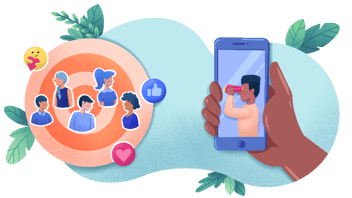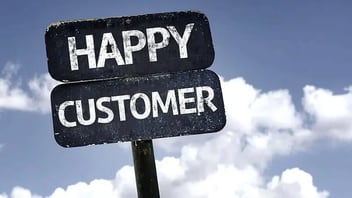What are Customer Retention and Churn Rates and How Do I Improve Them?
Have you ever gotten that sinking feeling when a customer cancels their service? It happens to the best of us. But what if you could turn those cancellations around or, better yet, avoid them? Loyal customers are worth their weight in gold, bringing in repeat business and positive word-of-mouth.
That's where customer retention management and churn rate controls come in.

What is Customer Retention?
Imagine your business as a leaky bucket. You're constantly adding new customers (filling the bucket), but if existing ones keep leaving (leaking out), you'll never have a full bucket, no matter how hard you pour. That's why customer retention is crucial. It's simply the percentage of customers who stick with your business over a specific period. The higher your retention rate, the fewer leaks you have, and the fuller your bucket remains.
So, why is keeping your happy customers so important? Here's the secret: existing customers are a goldmine. They've already experienced your product or service, so they're more likely to make repeat purchases. Customer Acquisition Costs are typically higher than the cost of maintaining a customer.
-
Acquiring a customer is 5-25 times more expensive than retaining one. [Harvard Business Review]
-
Customers who rate companies with a high customer experience score (i.e., 10/10) spend 140% more and remain loyal for up to 6 years. [SuperOffice]
This translates to increased revenue without the constant cost of acquiring new customers. Happy customers become loyal brand advocates, sing your praises and attract others through positive word-of-mouth.
The numbers speak for themselves. Studies show that retaining just 5% more of your customers can boost your profits by 25-95%. Imagine the impact that could have on your bottom line! Customer retention isn't just a nice-to-have; it's a key driver of sustainable business growth.
How to Calculate Customer Retention
This formula tells you what percentage of customers you were able to hold onto during a specific period.
-
Formula: Retention Rate = ((Starting Customers - Churned Customers) / Starting Customers) * 100
-
Example: Let's say you started a month with 100 customers. By the end of the month, 10 customers decided to cancel. To find your retention rate, subtract the churned customers (10) from the starting number (100) and then divide by the starting number (100). Multiply that result by 100 to express it as a percentage.
(100 customers - 10 churned customers) / 100 customers = 0.9 * 100 = 90% Retention Rate
In this example, you retained 90% of your customers during that month.
What is Churn Rate?
The customer churn rate is the flip side of the retention coin. It measures the percentage of customers who say goodbye to your business within a given timeframe, like a month, quarter, or year. Think of it as a leak gauge for your customer bucket. A high churn rate indicates a significant leak, draining your customer base and potentially leading to lost revenue.
But why is tracking churn so significant? It's like having a fever – it tells you something's wrong with your customer's health (satisfaction). A high churn rate might signal issues like poor customer service, lack of product value, or even problems with billing. By identifying these pain points early on, you can address them and prevent a customer exodus.
There are two main types of churn to be aware of: voluntary and involuntary.
-
Voluntary churn happens when a customer actively chooses to cancel your service. This could be due to reasons within your control (like pricing changes) or beyond your control (like a customer moving to a new location).
-
Involuntary churn occurs when you terminate a customer's service, often due to non-payment or inactivity.
Understanding the reasons behind both types of churn allows you to develop targeted strategies to plug the leaks and keep your customer bucket full.
How to Calculate Churn Rate
This formula flips the script and tells you the percentage of customers you lost within a specific period.
-
Formula: Churn Rate = (Churned Customers / Starting Customers) * 100
-
Example: Going back to our previous scenario, we know you started with 100 customers and lost 10 of them. To calculate your churn rate, simply divide the number of churned customers (10) by the starting number of customers (100) and multiply by 100.
(10 churned customers) / 100 customers = 0.1 * 100 = 10% Churn Rate
So, in this example, your churn rate for the month was 10%.
Remember: These formulas assume you know the number of customers you started with and how many churned during the specific period. Most customer relationship management (CRM) software can easily provide this data.
Strategies to Improve Customer Retention
Now that we've explored the concepts of customer retention and churn rate, it's time to turn the tide and focus on keeping your customers happy and on board. Here are some key strategies to improve your customer retention and prevent that leaky bucket from draining your business:
Identify Why Customers Leave
The first step to fixing a leak is figuring out where it originated. The same goes for customer churn. To understand why customers leave, you need to listen to their voices. Here are some effective ways to gather valuable customer feedback:
-
Surveys: Send out short, targeted surveys after a customer interaction (purchase, support ticket) or at regular intervals. Ask specific questions about their experience, satisfaction level, and any pain points they might have encountered.
-
Exit Interviews: When a customer cancels, reach out and conduct an exit interview. This allows you to delve deeper into their reasons for leaving and identify recurring issues.
By actively seeking feedback, you can uncover common reasons for churn, such as:
-
Poor Customer Service: Are your customers struggling to get help or resolve their problems? Invest in well-trained and empowered support staff to ensure you improve customer experience.
-
Lack of Value: Does your product or service meet customers' needs? Have your offerings evolved to keep pace with changing customer expectations? Conduct regular customer research to ensure that what you offer remains relevant.
Focus on Customer Satisfaction
Happy customers are loyal customers. The key to satisfaction lies in exceeding expectations at every touchpoint. Beyond simply meeting basic needs; strive to create an excellent customer experience. Here are some ways to achieve this:
-
Personalized Communication: Treat each customer as an individual. Tailor your interactions based on their past purchases, preferences, and needs. This demonstrates that you value them and are invested in their success.
-
Loyalty Programs: Reward your loyal customers for their continued business by offering tiered programs with exclusive benefits like discounts, early access to new products, or personalized recommendations.
Increase Customer Engagement
Engaged customers are less likely to churn. Why? Because they feel a sense of connection and value from your brand. Here are some ways to foster engagement:
-
Exclusive Content: Provide valuable content relevant to your customers' needs and interests. This could include blog posts, webinars, tutorials, or even exclusive access to industry experts.
-
Educational Resources: Equip your customers with the knowledge they need to get the most out of your product or service. Offer educational content like video tutorials, troubleshooting guides, or FAQs.
By implementing these strategies, you can transform your customer relationships from transactional interactions into long-term partnerships. Remember, a happy customer today is a loyal customer tomorrow, and that's the key to building a thriving and sustainable business.
Advanced Strategies: Winning Back Lost Customers
While the core strategies we've covered form a solid foundation for customer retention, there's always room to improve your efforts. Here are some strategies for winning back seemingly lost customers.
Win-Back Campaigns
Not all lost customers are gone forever. With well-crafted win-back campaigns, you can rekindle interest and bring past customers back into the fold. Here's how:
-
Segmentation is Key: Don't blast generic messages to everyone who churned. Segment your lost customers based on why they left (e.g., pricing concerns, lack of features). This allows for targeted messaging that addresses their specific pain points.
-
Personalized Offers: Don't just say, "We miss you." Offer incentives that directly address the reasons for their departure. This could be special discounts, exclusive product bundles, or free trials of new features. Use Aspiration Marketing's expertise in crafting compelling email sequences and targeted advertising campaigns to maximize the effectiveness of your win-back efforts.
Customer Segmentation
Not all customers are created equal. Segmenting your customer base allows you to tailor your retention efforts to their needs and values. Here's how it works:
-
Identify High-Value Customers: Use customer lifetime value (CLV) to identify your most valuable customers. These are the ones who bring in the most revenue and are highly likely to repeat business. Focus your retention efforts on keeping them happy by offering exclusive perks, priority support, or early access to new products.
-
Nurture Early-Stage Customers: New customers are more susceptible to churn. Address this by providing onboarding resources, personalized recommendations, and proactive support to ensure they get the most out of your product or service.
Retargeting
Even if someone doesn't convert on your website, they might still be interested in your offerings. Retargeting allows you to keep your brand in front of these website visitors through targeted ads displayed on other websites they frequent.
-
Personalized Ads: Don't just show generic ads. Use retargeting to display ads showcasing products or services relevant to their past browsing behavior. This personalized approach increases the likelihood of re-engagement and conversion.
-
Multi-Channel Approach: Combine retargeting with other retention strategies like email marketing for a multi-pronged approach. This reinforces your brand message across different touchpoints and maximizes the impact of your efforts. Aspiration Marketing's team can help you develop a comprehensive retargeting strategy that integrates seamlessly with your other marketing initiatives.
By implementing these advanced strategies, you can move beyond basic customer retention and build long-lasting, profitable customer relationships.
Invest in Retention, Reap the Rewards
Customer retention is no longer an afterthought; it's a strategic imperative. Loyal customers are the lifeblood of your business, driving repeat revenue, positive word-of-mouth, and brand advocacy. By understanding and managing customer churn, you can minimize leaks in your customer bucket and cultivate a thriving community of loyal brand ambassadors.
Ready to take the next step? Aspiration Marketing is here to help. Contact us today for a free consultation on how we can help you design and implement a customer retention strategy that drives sustainable business growth.
This content is also available in:
- German: Was sind Kundenbindungs- und Abwanderungsraten und deren Optimierung?
- Spanish: Los índices de Retención y de rotación: ¿Qué son y cómo mejorarlas?
- French: Que sont les taux de rétention et de désabonnement des clients ?
- Italian: Tassi di fidelizzazione e abbandono dei clienti: come migliorarli?
- Romanian: Ratele de retenție și pierdere clienți: cum le poți îmbunătăți?
- Chinese: 什么是客户保留率和流失率,如何提高它们?









Leave a Comment